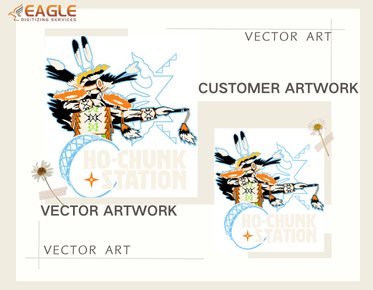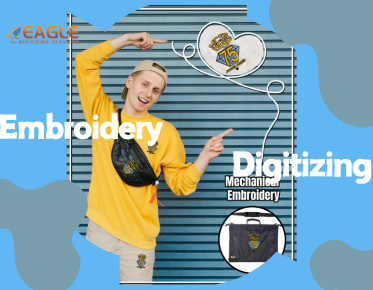Manual vs. Automated Vector Conversion: What’s Best for You?
Regarding vector conversion, the ongoing debate between manual
and automated methods is a hot topic. Both have their distinct advantages and
challenges. The manual approach provides unparalleled control and precision,
allowing designers to tweak every curve and detail. Meanwhile, automated
conversion tools promise speed and convenience, turning raster images into
vectors in a fraction of the time. Which method is right for you? Let’s explore
each approach in greater detail.
The Manual Approach: Precision and Control at Your Fingertips
What
is Manual Vector Conversion?
Manual vector
conversion is exactly what it sounds like manually tracing over a raster image
to create a vector version. This method is often done using software like Adobe
Illustrator or CorelDRAW, where the designer manually outlines paths and shapes
to replicate the original design. It requires a deep understanding of vector
tools and a steady hand to ensure accuracy. Manual vectorization is perfect
when you want to keep full control over the final result, particularly with
complex or custom artwork.
Advantages
of Going Manual: Attention to Detail and Customization
The biggest perk
of manual vector conversion is the level of detail and customization it allows.
Every curve, line, and shape can be adjusted to your exact specifications,
which is ideal for intricate artwork, fine details, or logos where precision is
key. Manual vectorization also lets you make creative choices, such as
adjusting line weights or adding custom textures. The result? A vector that is
uniquely tailored to your vision, with no compromises on accuracy or artistic
intent.
The
Tools of the Trade: Software and Techniques for Manual Vectorization
Tomanually vectorize an image, designers typically use vector graphics
software like Adobe Illustrator, which offers a robust set of tools for
creating precise paths and shapes. Techniques such as the Pen Tool, Direct
Selection Tool, and Anchor Point adjustments give designers the flexibility to
mold each element of the design. Mastering these tools takes time, but once
you’re comfortable with them, the possibilities for customization and
refinement are endless.
Challenges of Manual Vector Conversion
Time-Consuming
Tasks: The Trade-Offs of Going Manual
While manual
conversion offers the highest degree of control, it’s also incredibly
time-consuming. Tracing intricate designs or fine-tuning small details can take
hours—sometimes even days, depending on the complexity. This can be a challenge
if you're working under a tight deadline or need to produce a large volume of
designs quickly. The trade-off here is that you’re sacrificing time for
precision and creativity.
Skill
Matters: How Your Expertise Affects the Outcome
Manual vector
conversion is a skill that improves with experience. The more you practice, the
better you become at identifying the subtle nuances of an image and translating
them into smooth, clean paths. However, if you’re not highly skilled with
vector tools, you may find the process frustrating and prone to mistakes.
Mastering the Pen Tool, for example, can take some time, and inexperienced
designers may struggle with making perfect curves or angles.
Potential
for Human Error: How to Avoid Mistakes in Manual Conversion
One of the
inherent challenges of manual vectorization is the potential for human error.
Tracing paths by hand means you’re responsible for every line and curve, and
even small mistakes can lead to jagged edges or misplaced points. To avoid
these issues, it’s essential to zoom in on your work, use the grid and snapping
features, and take frequent breaks to prevent fatigue. Also, always
double-check your work before finalizing the vector file to ensure everything
is precise.
The Automated Approach: Speed, Efficiency, and Ease
What
is Automated Vector Conversion?
Automatedvector conversion involves using software to convert raster images into vector files
with minimal human input. Tools like Adobe Illustrator’s Image Trace or online
services like Vector Magic use algorithms to detect shapes, colors, and edges
in a raster image and automatically convert them into vectors. This approach is
perfect for those who need quick results and don’t require intricate
customization.
How
Does Automation Work? The Technology Behind the Scenes
At its core,
automated conversion relies on sophisticated algorithms that analyze the
pixel-based image and try to map it into smooth vector paths. The software
identifies edges, contours, and color zones in the image and uses these to
generate paths and fills. While this process is relatively quick, the
technology isn’t perfect—it might struggle with complex gradients or intricate
details, which can result in a less-than-perfect vector.
The
Speed Advantage: Why Automation Saves Time
The most
significant advantage of automated vector conversion is its speed. What might
take hours manually can often be completed in a matter of minutes with
automation. This makes it ideal for projects that require fast turnarounds or
large volumes of work. If time is a priority, automated tools are an attractive
option, especially for simpler designs where precision isn't as critical.
Challenges of Automated Vector Conversion
The
Limitations of Automation: Accuracy and Detailing
While automation
is fast, it isn’t perfect. Complex designs with fine details, like shading,
textures, or gradients, often don’t translate well into vector formats.
Automated tools may fail to capture the subtleties of the original image,
leaving you with a crude version of your design that needs significant
post-processing to refine. In these cases, manual intervention is necessary to
fix inaccuracies.
Lack
of Customization: Why Automation Isn’t Always a Perfect Fit
Automated tools
often lack the customization options that come with manual conversion. If you
need to tweak specific elements—adjusting shapes, adding personal flair, or
optimizing curves—automation can be limiting. While it works great for standard
shapes and straightforward designs, it doesn’t offer the flexibility to create
something truly unique or customized to your exact vision.
How
Automation Handles Complex Designs: Where It Struggles
Complex designs
with intricate patterns, shading, or fine lines can overwhelm automated
systems. The algorithm may miss important details or produce jagged edges
instead of smooth curves. For designs that require finesse, automation can feel
like a poor substitute for manual vectorization, leaving you with a result that
needs heavy refinement.
Key Factors to Consider: Manual or Automated?
Complexity
of the Design: Simple vs. Intricate Artwork
One of the first
things to consider is the complexity of the design. For simple graphics like
logos, icons, and basic illustrations, automation will often suffice. However,
if you’re dealing with detailed artwork, such as fine art, illustrations with
lots of gradients, or highly intricate logos, manual vectorization is the
better option. It allows you to capture the subtle details that automation
might miss.
Desired
Quality: When to Opt for Perfection Over Speed
If the quality of
the vector matters to you, especially for high-end projects like branding or
print materials, manual conversion is often the better choice. It may take longer,
but the level of detail and control it offers will result in a sharper, more
refined final product. On the other hand, if you’re working with a simple
design or under time constraints, automated conversion can provide a quick and
adequate solution.
Your
Budget: How Cost Plays Into Your Decision
Manual conversion
often requires more time and skill, which means it can be more
expensive—especially if you’re hiring a designer. Automated tools, however, are
generally more cost-effective since they eliminate the need for skilled labor.
If you're on a tight budget and the design is simple, automation might be the
most cost-efficient solution.
Time
Constraints: When You’re in a Rush vs. When You Have Time to Spare
Time plays a
significant role in choosing between manual and automated conversion. If you're
on a tight deadline and need a quick turnaround, automated tools can help you
meet those demands. But if your project allows time for a more thoughtful,
detailed approach, manual conversion ensures a higher level of quality.
The Best Use Cases for Manual Vector Conversion
Complex
Artwork: Turning Detailed Images Into Vectors
When working with
intricate designs, detailed illustrations, or fine art, manual vectorization is
often the best choice. This method allows designers to painstakingly trace
every detail, preserving the integrity and subtleties of the original artwork.
Custom
Projects: How Manual Conversion Gives You Creative Control
For custom
projects that require a high degree of originality, manual vectorization allows
you to have full creative control. Whether you're designing a unique logo or
turning a custom illustration into a scalable vector, manual methods provide
the freedom to make adjustments at every step.
Fine
Art and Illustration: Why Some Designs Demand a Personal Touch
Fine art and
hand-drawn illustrations often require a personal touch that automation can’t
replicate. Manual vector conversion allows for the care and attention needed to
capture every brushstroke, texture, and unique aspect of the original artwork.
The Best Use Cases for Automated Vector Conversion
Logos
and Simple Graphics: When Speed is Key
Automated
conversion excels in creating vectors for logos,
icons, and simple graphics. These designs are typically made up of basic shapes
and solid colors, making them ideal candidates for quick automated conversion.
Projects
with Tight Deadlines: How Automation Can Help You Meet Time Constraints
When you’re
facing tight deadlines and need to turn around vector files fast, automated
tools are a lifesaver. They can generate a vector file quickly, allowing you to
meet deadlines without sacrificing too much quality—particularly for
straightforward designs.
Bulk
Projects: Why Automation is a Game-Changer for Large Volumes
If you’re
handling large volumes of simple designs, automation tools are invaluable.
Whether you're working on a series of icons, patterns, or logos, automation can
speed up the process, saving you hours of manual labor.
How to Choose Between Manual and Automated Conversion for Your Project
Assessing
Your Needs: What’s More Important—Speed or Detail?
The first step is
determining what's more important for your project—speed or detail. If you need
high-quality, detailed work and have the time and budget for it, manual
conversion is the way to go. However, if you need something quick and simple,
automated conversion may be your best option.
Understanding
Your Design’s Requirements: Is It Simple or Complex?
The next step is
assessing your design’s complexity. Simple designs like logos or icons are best
suited for automated tools. But if you’re dealing with detailed illustrations
or complex images, manual conversion will ensure that every nuance is captured
accurately.
How
to Set Realistic Expectations: What to Know Before You Decide
Before deciding,
it’s crucial to understand the strengths and weaknesses of both methods. Set
realistic expectations based on your project’s needs. While automated
conversion offers speed, it may lack the detail you desire. Manual conversion,
on the other hand, offers precision but requires more time and expertise.
Whether you choose manual or automated vector conversion ultimately depends on your project’s needs, timeline, and desired outcome. For intricate, detailed designs, manual conversion provides unmatched precision and creative control. For simpler designs or fast turnarounds, automated tools offer speed and efficiency. By understanding the pros and cons of each method, you’ll be equipped to make the best choice and deliver a final product that meets your expectations.



 Embroidery Digitizing.png)